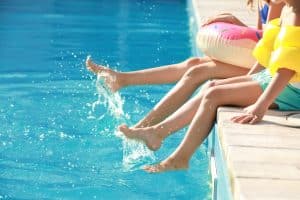It’s Time for America to Address Its Drowning Crisis
 This summer has been hot – freakishly hot. We saw record-breaking temperatures across the country throughout July. Chicago may not have had it as bad as some other places (the ocean off the coast of Miami hit 100 degrees!) but it’s still been a sweltering summer. For many, the only relief from the heat has come from private and public pools.
This summer has been hot – freakishly hot. We saw record-breaking temperatures across the country throughout July. Chicago may not have had it as bad as some other places (the ocean off the coast of Miami hit 100 degrees!) but it’s still been a sweltering summer. For many, the only relief from the heat has come from private and public pools.
And yet for so many families, what should be a fun family day ends in tragedy.
According to Illinois.gov, in 2021, 18 Illinois families were broken apart by a drowning incident that took one of their children. The situation mirrors the nationwide trend, as reported by The New York Times. While overall drowning deaths have decreased by one-third since 1990, the year 2020 saw a troubling surge with a 16.8 percent increase in drowning incidents.
Annually, there are still over 4,000 drowning deaths in the United States, with approximately a quarter of these tragic incidents involving children. Drowning is the number one cause for unintentional death for children ages one through four and the second leading cause for children ages one through 14.
Moreover, a stark disparity exists in drowning rates among different racial and ethnic groups. The Centers for Disease Control and Prevention (CDC) analysis reveals disturbing statistics where Black children between the ages of five and nine are 2.6 times more likely to drown in swimming pools compared to white children in the same age group. This inequality worsens for Black children between the ages of 10 and 14, who are 3.6 times more likely to drown in swimming pools.
These findings underscore the urgent need to address not only general water safety measures, but also the systemic issues that hamper access to water safety education in urban areas. This is a public safety issue, a public funding issue, and a public education issue that must be addressed, not only in Illinois but across the country.
What do local communities need to do to improve water safety?
Addressing the drowning crisis requires a collective effort from communities, policymakers, and institutions to promote water safety especially in under-funded communities. Here are two essential steps that would foster a safer future for all Chicago children:
- Enhanced public access to swim instruction: Implement targeted water safety programs tailored to communities, including swimming lessons, life-saving techniques, and awareness campaigns. Partner with local schools for culturally sensitive outreach and education to reach all children, especially those in the above listed communities that are at higher risk of drowning incidents.
- Increased lifeguard and swim instructor incentives: This highlights a major problem in water safety. According to axios.com, “About one-third of more than 309,000 public pools are affected by the staffing shortage, per estimates from the American Lifeguard Association.” With a water safety personnel shortage, it may fall on public policy makers to allocate more tax payer dollars to raising the hourly pay for these vital safety workers. This incentive will not only keep public pools under vigilant watch but also attract dedicated swim instructors to educate young Chicagoans on how to be safe in the water.
What are five water safety measures that all families should take?
While addressing liability is necessary after a drowning event, the focus should be on preventive measures and water safety education. Empowering parents, caregivers, and communities with the knowledge and skills to protect children from drowning incidents is paramount. Here are some steps to take to better insure water safety for your family:
- Enroll children in swimming lessons: Teaching children to swim from an early age can greatly reduce the risk of drowning. It is crucial to ensure that swimming lessons are conducted by qualified instructors in safe environments.
- Educate children on water safety: Teach children about the dangers of water and the importance of never swimming alone or without adult supervision.
- Learn CPR and first aid: As an adult or a young person, having an understanding of this life-saving skill can make a world of difference in the event of a drowning incident.
- Secure pools and water features: Install secure fencing with self-latching gates around pools and other water features to prevent unsupervised access.
- Supervise diligently: Active and vigilant supervision is vital whenever children are in or near water. With new video surveillance technology that can be installed in your phone, it is advisable to have notifications activated for whenever the pool gate is opened. Avoid distractions and designate "water watchers" during pool parties or gatherings.
With all of these safeguards in place these tragedies can be avoided. But when these safeguards are ignored by pool owners they should be held responsible for any harm caused by their negligence.
Drowning isn’t always fatal, but it is always serious
A drowning incident may not be fatal; people can and do survive drowning incidents. But the damage can be permanent, as most victims suffer some level of brain damage as a result of oxygen deprivation. It only takes a couple inches of water to pose a risk, and it only takes a few minutes before irreparable brain damage sets in.
What is the “attractive nuisance” doctrine?
Understanding who is responsible for drowning accidents can be complex. Many factors play a role, like where the accident happened (at a public place or someone's private property), the age of the victim, and the circumstances of the incident. When it comes to private pools, there is something called the "attractive nuisance" doctrine. This legal concept holds property owners accountable if someone gets hurt or dies on their property, especially if children are involved.
The reason for this concept's name, “attractive nuisance”, specifically refers to the allure that a dangerous item has to a child or vulnerable adult. It attracts attention, sparking curiosity in a person who may not understand the dangers; a private pool is a clear example of an attractive nuisance. So, property owners have a duty to take reasonable steps to keep kids away from these dangerous places. For private pool owners, it's essential to understand that children in the neighborhood might be drawn to their pool. Installing barriers like fences, gates, and pool covers can help keep kids from getting in without supervision.
All of us at Gainsberg Injury and Accident Lawyers want you to enjoy the rest of your summer. But we also want you to be safe. If a dangerous pool caused you or your child harm, you do have legal options. Call or contact us in Chicago to learn more about your rights.

Attorney Neal Gainsberg has spent the last 20+ years fighting to protect the rights of the injured in Chicago and throughout Illinois. For dedicated legal help with a personal injury, car accident, or wrongful death matter, contact Gainsberg Injury and Accident Lawyers in Chicago for a free consultation.
